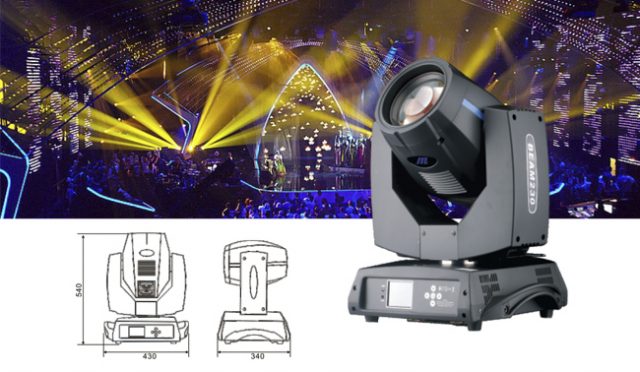Stage beam light is a high-tech product integrating electronics, machinery and optics. A qualified beam light must be stable and reliable, with excellent light efficiency, accurate positioning and good heat dissipation. The light body and material structure meet the requirements of ergonomics.
In summary, the stage moving head light is composed of three major systems: optical, mechanical, electrical and program control. The three major systems are interconnected and organically combined to meet the needs of light, color, speed, direction, effect, heat dissipation, noise, and positioning.
Optical system of stage beam moving head light
The design of the optical system mainly considers the utilization of the lumen flux of the light source. Specific performance factors include light intensity, uniformity, saturation, and spot size. There are two aspects that affect the above elements, one is the light source, and the other is the structure and material selection of the optical system. At present, most domestic and foreign manufacturers recommend OSRAM or PHILIPS metal discharged bulbs. Roccer brand bulb also with high brightness and long life, and are well received by customers at home and abroad.
Its characteristics are compactness, high brightness, high color temperature, good color rendering, and the light source can maintain a relatively stable color temperature during the dimming process. In the optical structure, to obtain a uniform mixed beam, a parabolic reflector is generally used; to collect divergent or narrow beams, a reflector with scale processing or surface texture is generally selected. When several beams need to be obtained from one light source, a prism or lens combination refractive system can be used.
Mechanical system of stage beam moving head light
The mechanical system includes a wide range, including materials, structure, mechanical properties, housing requirements, and heat dissipation properties. The lighting material priority is to meet the functional requirements of the lamp, the manufacturing process and the economy. At present, the materials of 230W beam lights are mainly steel, plastic and aluminum alloy. On the premise of satisfying the overall function of the light, different materials are used for different design positions.
The structure of the light determines its mechanical properties, heat dissipation, strength, noise, weight and other factors. The 230W beam light adopts a two-arm support structure. The light body can be rotated horizontally up to 540 degrees and vertically rotated up to 250 degrees. The base must be strengthened to meet the requirements of the beam lamp being suspended upside down.
The mechanical properties of the light body are mainly reflected in the mechanical strength of the light parts, so that the light does not deform, wear-resistant, corrosion-resistant, pressure-resistant, and shock-resistant during the continuous and effective working time. The housing of the light must have strict water, dust, static, and moisture requirements. According to the degree of waterproof and dustproof, it is divided into different enclosure protection requirements: for example, the protection requirement level for indoor light is usually IP20, and for outdoor beam light is usually IP65.
The mechanical and heat dissipation requirements of high-power beam light are very important. If there is a defect in the cooling system, it will usually cause parameter drift, lens rupture, plaque, and severe consequences such as crashes, out of step, and uncontrollability.
Electrical and program control part of stage beam moving head light
Most professional 230W stage moving head beam lights use rare gas discharge bulb light sources. The start and stable operation of the gas discharge bubble depends on the design of the circuit type, the choice of electrical components such as power supply, ballast and so on. After a rare gas discharge light bulb is started, it generally does not need a stable time. During the entire AC cycle, the difference between the circuit’s sustaining voltage and the instantaneous voltage of the light bulb should be sufficiently large.
When the light is started, stability, extinguished, and restarted, the circuit should be designed according to the characteristics of the light source. The starting voltage of rare gas discharge bulbs is very high, requiring the use of transformers, starting devices, semi-resonant circuits, etc. to increase the instantaneous starting voltage. The stability of the light source after startup depends on the matching of ballast and circuit parameters. The basic function of the ballast is to prevent current runaway and make the light source work under its normal electrical characteristics.
The restart of the light source, in the conventional circuit design, due to the high temperature generated when the gas discharge bulb is operating, the saturated gas in the bulb forms a vapor pressure resistance, and it is difficult to realize the light source to be triggered again immediately. The gas pressure in the bulb must be reduced to a cold value before triggering a restart.

